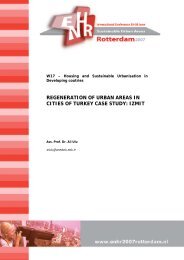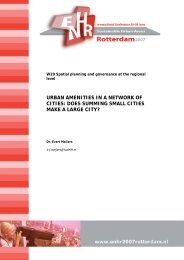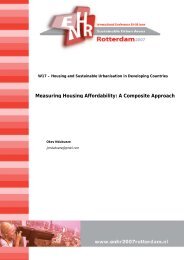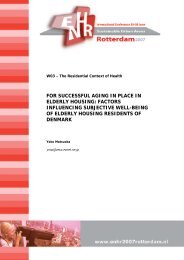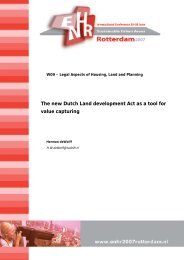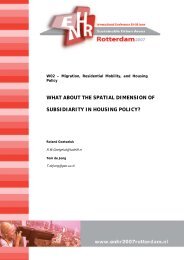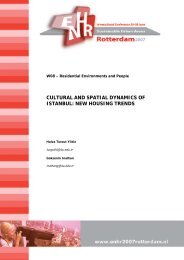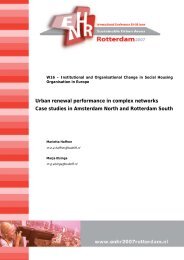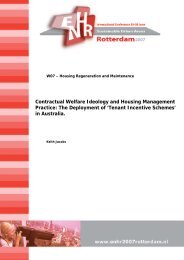Download abstracts - ENHR 2007 Rotterdam
Download abstracts - ENHR 2007 Rotterdam
Download abstracts - ENHR 2007 Rotterdam
Create successful ePaper yourself
Turn your PDF publications into a flip-book with our unique Google optimized e-Paper software.
Attracting creative knowledge: Strategies towards competitiveness in Amsterdam and<br />
Barcelona<br />
Marco Bontje 1 // M.A.Bontje@uva.nl, Montserrat Pareja Eastaway 2<br />
1 University of Amsterdam, Amsterdam, NETHERLANDS<br />
2 University of Barcelona, Barcelona, SPAIN<br />
Amsterdam and Barcelona recently seem to have become direct competitors in terms of<br />
attractiveness as a business location. In the most recent European Cities Monitor, Barcelona is<br />
4th and Amsterdam 6th in the list of 'best cities to locate a business today'. Amsterdam was far<br />
ahead of Barcelona on that list for years, but Barcelona has meanwhile caught up and even<br />
passed by. Barcelona is often presented as an example of successful urban regeneration,<br />
strategic economic and cultural development planning, and city marketing. Certainly, the<br />
current position of the city in the international landscape is explained as the result of a long<br />
term strategy which already started during the preparation for the Olympic Games candidacy in<br />
the 1980s. Amsterdam's attempts to become more competitive have started much more<br />
recently, partly in reaction to the perceived 'lost ground' to cities like Barcelona. Until last year,<br />
there actually was no such thing as an integral competitiveness strategy. The attempts to make<br />
the city and city-region more competitive rather happened 'piecemeal' in unrelated sectoral<br />
initiatives.<br />
In our paper we want to compare the current and past strategies towards competitiveness of<br />
both cities and their city-regions, with particular attention for the recently increased importance<br />
of attracting creative and knowledge-intensive industries. How much influence has Barcelona's<br />
competitiveness strategy since the 1980s had on the current situation Which positive and<br />
negative effects did it have on the city and the city-region Which other factors contributed to<br />
Barcelona's increased competitiveness And, seen against the Barcelona experience, what<br />
effects can Amsterdam expect from its competitiveness strategy<br />
Gentrification in a globalising world, case study: Istanbul<br />
Nihal Coskun // cos15n@yahoo.com, Burcu Selcen Yalcin<br />
Mimar Sinan Fine Arts University, Istanbul, TURKEY<br />
Today, there is a tendency to regenerate the historical cores of many cities in different<br />
locations of the world. Nevertheless, the efforts of their rehabilitations frequently bring a serious<br />
problem of gentrification of the neighbourhood which result in the changing of the inhabitants<br />
involuntarily.<br />
'Gentrification' in a large scale may surely be regarded as an inevitable fact related with the<br />
capitalist restructuring systems of the world. Many cities located on different territories of the<br />
world with variable economical, political and social characteristics come face to face with this<br />
reality in relationship with how much the city is open to globalising currencies. On the other<br />
hand, gentrification could be considered as a ‘place’ related fact. Although it should be<br />
regarded as an international reality, gentrification of the dilapidated historic neighbourhoods in<br />
different cities of the world may surprisingly show different responds compared to eachother.<br />
In this paper, examples of gentrification period from a metropolitan city, Istanbul will be given to<br />
clarify this diversity in regard with socio-economical and cultural aspects of this fact.<br />
This paper aims to give an overall picture of gentrification movements affected by the local<br />
parameters which are special only for this city; the differences occured in different<br />
neighbourhoods and the innovatives which give a start to this period beginning from 1980’s.<br />
Within this frame, other examples except for the general negative ones which unfortunately<br />
rule this change, others will be studied. In our opinion, these ‘other’ examples rise new hopes<br />
for the future of gentrification in Istanbul by including the inhabitants of the neighbourhoods to<br />
this period that may result in a more sustainable way of life.



